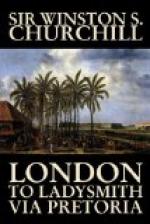Later in the day we rode out to find some nearer listening point. The whole force was making a reconnaissance towards Colenso, partly for reasons of security, partly to exercise the horses and men. Galloping over the beautiful grassy hills to the north of the town, I soon reached a spot whence the column could be seen. First of all came a cyclist—a Natal volunteer pedalling leisurely along with his rifle slung across his back—then two more, then about twenty. Next, after an interval of a quarter of a mile, rode the cavalry—the squadron of the Imperial Light Horse, sixty Natal Carabineers, a company of mounted infantry, and about forty of the Natal mounted police. That is the total cavalry force in Natal, all the rest is bottled up in Ladysmith, and scarcely three hundred horsemen are available for the defence of the colony against a hostile army entirely composed of mounted men. Small were their numbers, but the quality was good. The Imperial Light Horse have shown their courage, and have only to display their discipline to equal advantage to be considered first-class soldiers. The Natal Carabineers are excellent volunteer cavalry: the police an alert and reliable troop. After the horse the foot: the Dublin Fusiliers wound up the hill like a long brown snake. This is a fine regiment, which distinguished itself at Glencoe, and have since impressed all who have been brought in contact with it. The cheery faces of the Irishmen wore a proud and confident expression. They had seen war. The other battalion—the Border Regiment—had yet their spurs to win. The volunteer battery was sandwiched between the two British battalions, and the rear of the column was brought up by the Durban volunteers. The force, when it had thus passed in review, looked painfully small, and this impression was aggravated by the knowledge of all that depended on it.
A high, flat-topped hill to the north-west promised a wide field of vision and a nearer listening point for the Ladysmith cannonade, which still throbbed and thudded dully. With my two companions I rode towards it, and after an hour’s climb reached the summit. The land lay spread before us like a map. Estcourt, indeed, was hidden by its engulfing hills, but Colenso was plainly visible, and the tin roofs of the houses showed in squares and oblongs of pale blue against the brown background of the mountain. Far away to the east the dark serrated range of the Drakensberg rose in a mighty wall. But it was not on these features that we turned our glasses. To the right of Colenso the hills were lower and more broken, and the country behind, though misty and indistinct, was exposed to view. First there was a region of low rocky hills rising in strange confusion and falling away on the further side to a hollow. Above this extensive depression clouds of smoke from grass and other fires hung and drifted, like steam over a cauldron. At the bottom—invisible in spite of our great elevation—stood the town and camp of Ladysmith. Westward rose the long, black, hog-backed outline of Bulwana Hill, and while we watched intently the ghost of a flash stabbed its side and a white patch sprang into existence, spread thinner, and vanished away. ‘Long Tom’ was at his business.




